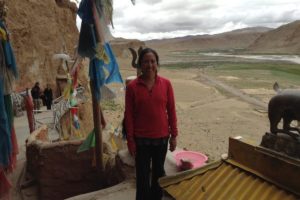
We’re excited to share a recent photo essay from Emily Yeh, Professor and Department Chair of Geography at CU Boulder. We were fortunate to have professor Yeh join ICI for our Sacred Himalaya Initiative trek to northwest Nepal and western Tibet in 2016. As you will see from her photos, this was an extremely amazing–and educational–opportunity for all involved. Below is a brief excerpt from her post accompanying the photos.
Mount Kailash, or Gang Rinpoche (Gangs rin po che), is associated with Mt. Meru, the axis mundi or center of the world, and is thus considered one of the world’s most sacred mountains. Four major rivers – the Indus, Sutlej, Brahmaputra, and Karnali – originate in the four cardinal directions nearby. As such, it is a destination for pilgrimage and circumambulation for Tibetan Buddhists, Bonpos, Hindus, and Jains. Tibetan Buddhists consider it a dwelling place of Demchog (Chakrasamvara) and for Hindus it is the abode of Lord Shiva. For Jains, it is the place where the first Tirthankara attained enlightenment, and for Bonpos, Mt Kailash is a nine-story swastika mountain that is the seat of spiritual power. Moreover, the region of the mountain and nearby Lake Manasarovar is where Thonpa Sherab founded and disseminated Bon…
Our visit to Kailash, Manasarovar, and the associated sacred site of Tirthapuri was motivated by a proposal by ICIMOD to have Nepal, India, and China nominate the larger Kailash Sacred Landscape as a transboundary World Heritage Site. Our goal was to understand historical pilgrimage routes, document the cultural landscape, assess current tourism, and seek to understand what effects such a designation, were it to come to pass, might be.
You can read the rest of her post and see her photos here.
You can alse find an earlier account and photo essay from this same trip that she published last October, focused on the Nepal side of the trip in Limi Valley. As she wrote in that post:
In July-August 2016, I was very fortunate to be able to join the Sacred Himalaya Initiative of the India-China Institute at The New School, in a trip through Humla to Mount Kailash. Led by Ashok Gurung, we were a crew of Americans, Nepalis, and Indians supported by a number of cooks and porters. Although the centerpiece of the journey was Mount Kailash, we spent much more of our time walking through Humla District in the Karnali Zone and in the northwestern corner of Nepal, much of which was once part of Ngari in western Tibet. Its district headquarters, Simikot, is currently accessible only by plane or foot. We spent five days walking in the Tibetan Buddhist Nyin valley to the east, home of Tshewang Lama, a former politician as well as lama, businessman, and organic intellectual who accompanied us throughout the trip. Then after returning to Simikot, we split into two groups, one taking the shorter route to the border at Hilsa through Muchu and Tumkot, and the other (including me) the longer northern route over the Nyalu pass through the isolated Limi Valley.
You can read the rest of her post and see her photos here.
